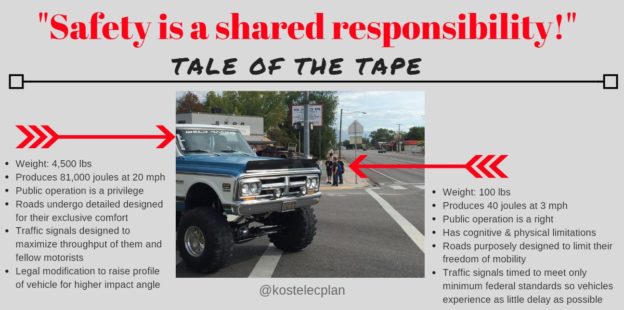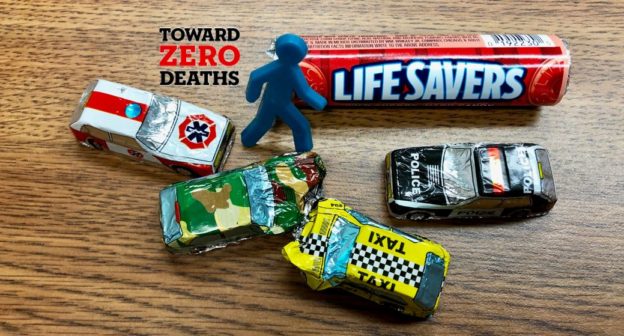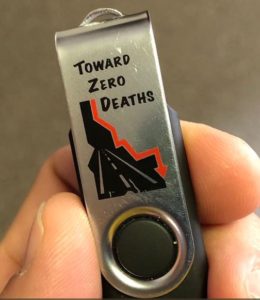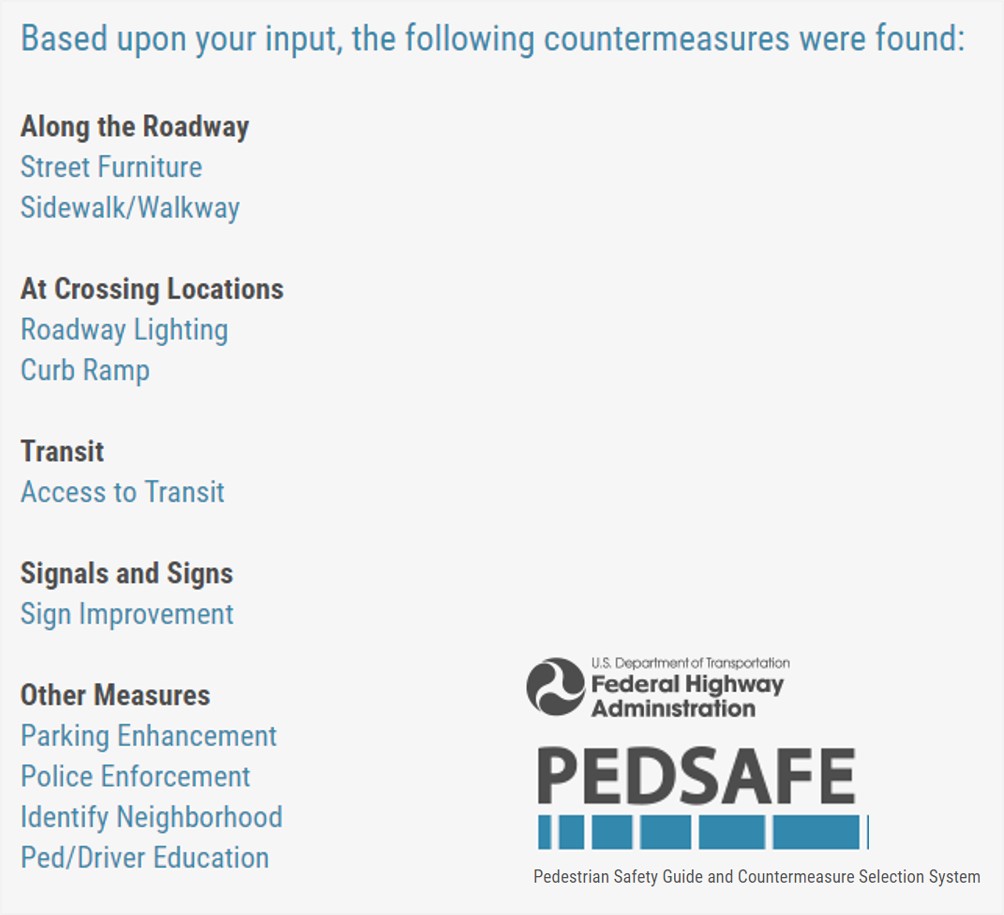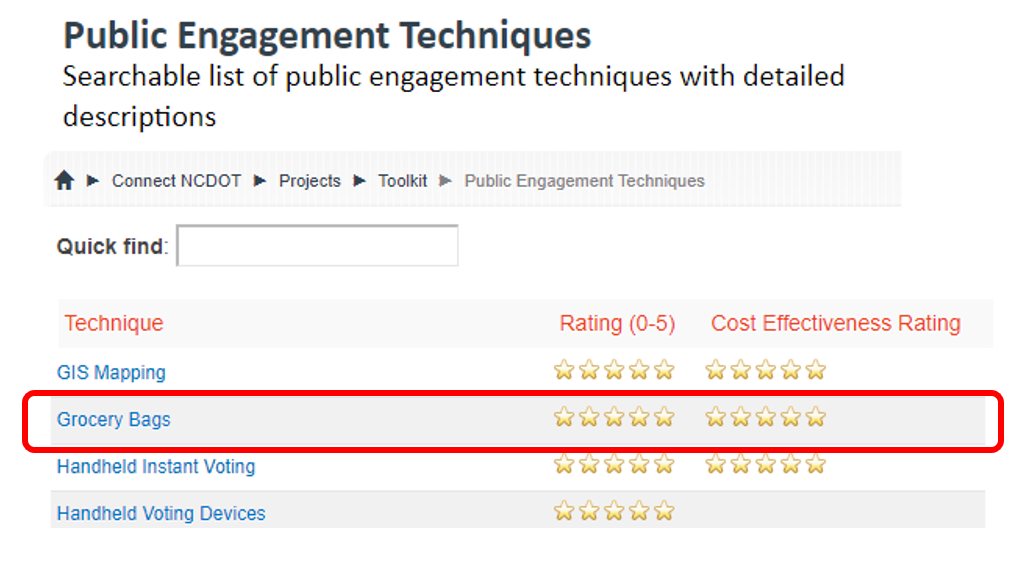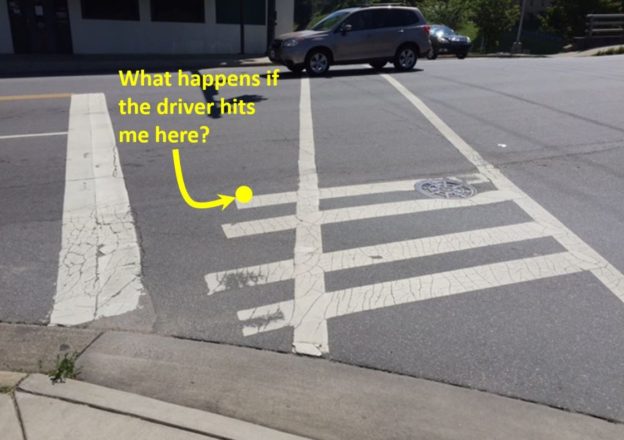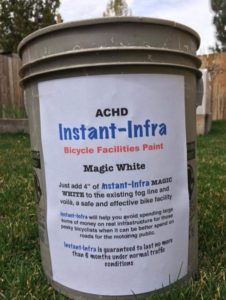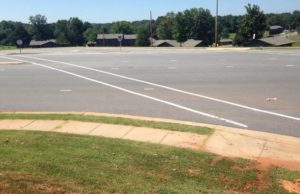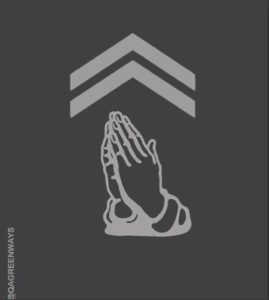The 12 Days of Safety Myths
December 13, 2018
by Don Kostelec
A child, all of 100 pounds, is mowed down by a person driving a 4,500-pound pickup truck. What will you likely hear from police officers, highway safety engineers, Governors Highway Safety Association, and state DOTs? “Now, remember, children, safety is a shared responsibility!”
Bull pucky.
Shared responsibility on the road isn’t a valid expectation of people who walk and bike until they are given equal consideration in road design and equal opportunity to move safely throughout the system.
Hot off the presses this week is this shared responsibility, victim-blaming spot featuring the Pennsylvania DOT and law enforcement in the Harrisburg area. It’s probably the worse example of overt victim-blaming I’ve seen. The media sops it up like a dog that hasn’t eaten in a month.

The media can’t be bothered to interview someone who actually walks or bikes to get somewhere. The story recites out-dated public right-of-way laws that were developed in an era when motordom was exerting its lobbying influence on the highway safety realm. They attempt to show balance in the headline by mentioning motorists but the story is heavily slanted toward blaming pedestrians. A cop cites anecdata, saying pedestrians are almost always at fault, most likely derived from interviewing drivers after they kill pedestrians, who then have no ability to defend themselves.
Origins
Admittedly, I’m still trying to piece together the history of the “safety is a shared responsibility” mantra. Peter Norton’s book Fighting Traffic, chronicles the underlying movements of motordom that led to the car-dominated set of road design standards and laws we have today. These efforts of the early 20th century worked to eliminate anything other than cars from the use of roadways. The entire effort was intended to make someone other than the motorist look responsible for the carnage caused by the automobile, knowing that if cars had a bad reputation for safety they could never been mass-marketed the way automakers needed them to be. Despite early outcry over the prevalence of motor killings, by the 1930s attitudes had shifted, as Norton writes:
- “The car had already cleaned up its once bloody reputation in cities, less by killing fewer people than by enlisting others to share the responsibility for the carnage.”
In seeking to find how this morphed into traffic safety doctrine, I asked the twitterverse to help me find the history. In bits and pieces over the years I’ve heard that it went full throttle with the automobile insurance industry’s desire to absolve policyholders of responsibility and shift blame to the vulnerable road users. It is a way to keep policy costs low and deflect from the carnage their clients cause.
A clue emerged when @bettybarc0de did a search for “safety is a shared responsibility” through Google Ngram, which charts the frequency of phrases by the timeframe in which they are used. The 1970s seem to the time in which the use of the phrase accelerated.
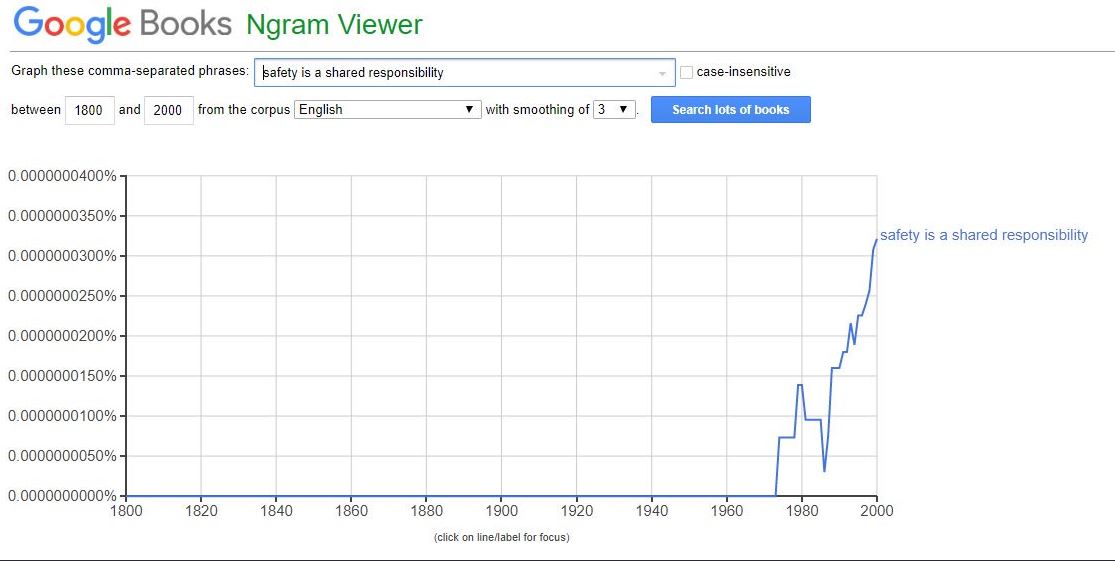
In looking up the history of compulsory automobile insurance I found that our modern-day requirements became prevalent in the 1970s. Automobile owners prior to then had some requirements regarding financial responsibility but it wasn’t like our current compulsory insurance framework that became the standard among states during this timeframe.
This may explain the connection between use of the phrase and scheming by the auto insurance industry. Finding out more is on my to-do list.
Physics & Human Nature Suggest Otherwise
It easy to comprehend how shared responsibility could be a rational expectation between two motor vehicles of similar mass, speed capabilities, and built-in safety features. That’s a place where the automobile insurance industry has a point. It’s kinda like two college students sharing responsibility for academic performance in the same class. Or two pedestrians negotiating the same space on a sidewalk. They are equivalents in most respects.
I snapped the image in the graphic below while we were doing walk audit training in Clearfield, Utah. It was the end of a school day at a nearby middle school and these kids were walking along a state-managed route and attempting to cross this state-managed intersection. In a show of “right of might,” the driver of the modified pickup truck expressed his dominance on the roadway by encroaching on their space. (Search Bill Schulteiss’ great hashtag #AmbassadorsOfSharedResponbility to see more great examples)
I oftentimes caption this picture as “Go ahead and cross, children, I dare you. The signal says WALK!” (fades out to the tune of “Walk” by Pantera.). I’d conceptualized this graphic like you would a boxing match the Tale of the Tape. The goal is to point out how the basic physics of this situation prove the “safety is a shared responsibility” to be a ill-informed postulation.
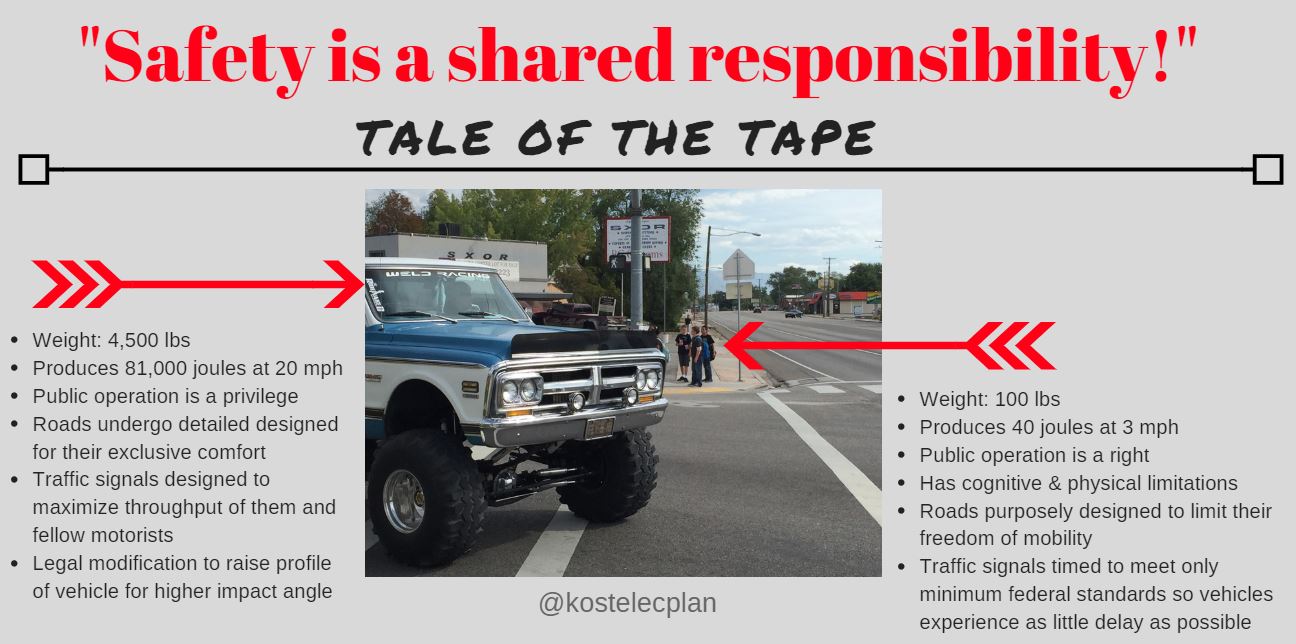
Let’s start with the mass of the two objects that are expected to share this responsibility. One is at least 4,500 pounds and produces 81,000 joules at 20 mph. The others weigh 100 pounds each, producing 40 joules at 3 mph. Joules are a measurement of kinetic energy based on a function of weight and mass. It’s the transfer of kinetic energy that kills people in a crash.
The catastrophic consequences of these two objects colliding is compounded by traffic engineering practices where roads undergo detailed design for the exclusive comfort and speed of the 4,500-pound object. Traffic signals are timed to maximize their efficiency and ensure that average operating speed is as high as possible, especially on state-managed routes like this one.
The driver is allowed, by law, to raise the profile of the vehicle so it makes the impact zone upon a pedestrian higher on the body and almost ensuring the collision occurs in the torso or head region instead of on the legs. The exerts more force on more vulnerable sections of the body and pulls the victim underneath the vehicle.
Nothing in the engineering of this roadway or the modifications to this truck suggests the driver shares any responsibility. That perspective is what’s lacking in the Harrisburg story I cited at the start of this post.
“Well, those kids need to know they could die if hit by that car, that’s why they share the responsibility!” That’s the grunt reply that active transportation advocates get when they try to point out these basic facts of physics and vehicle characteristics.
That’s when I turn to the research. The table below is from the report Improving Pedestrian Safety at Unsignalized Crossings and derived from a Florida DOT pedestrian safety handbook.
Just read through the table. As you read it, repeat the mantra “safety is a shared responsibility” after each bullet point. As much as we may try, there is no way we can educate human nature out of children to get them to magically conform to the inconsistent elements of our traffic laws.
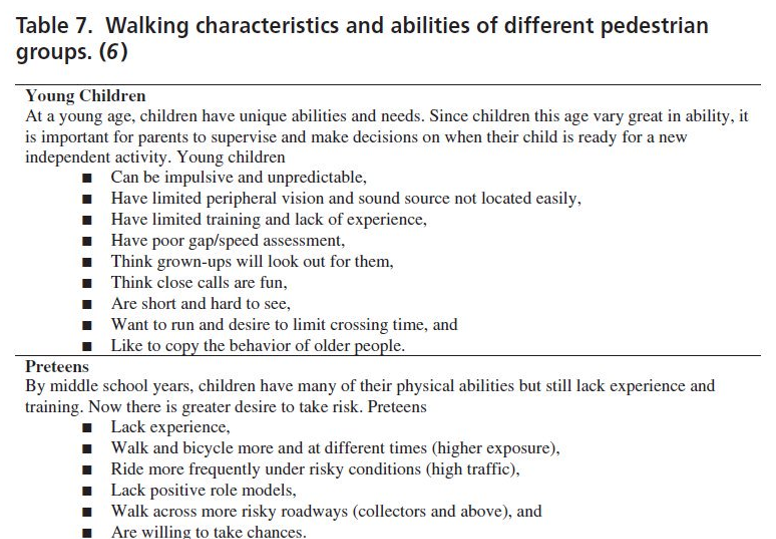
The report also characterizes walking abilities of older adults:
- They have difficulty in selecting safe crossing situations in continuously changing complex traffic situations, likely because of deficits in perception and cognitive abilities, as well as ineffectual visual scanning, limitations in time sharing, and inability to ignore irrelevant stimuli.
- They have difficulty in assessing the speed of approaching vehicles, thus misjudging when it is safe to cross the road.
- They have slower reaction time and decision making.
- Those with arthritis may have restricted head and neck mobility as well as difficulty walking.
Even the AASHTO Guide for the Planning, Design, and Operation of Pedestrian Facilities, which is referenced 30 times in the latest 2018 publication of the 1,048-page AASHTO Green Book, aligns with this report. The table included in this guide states:
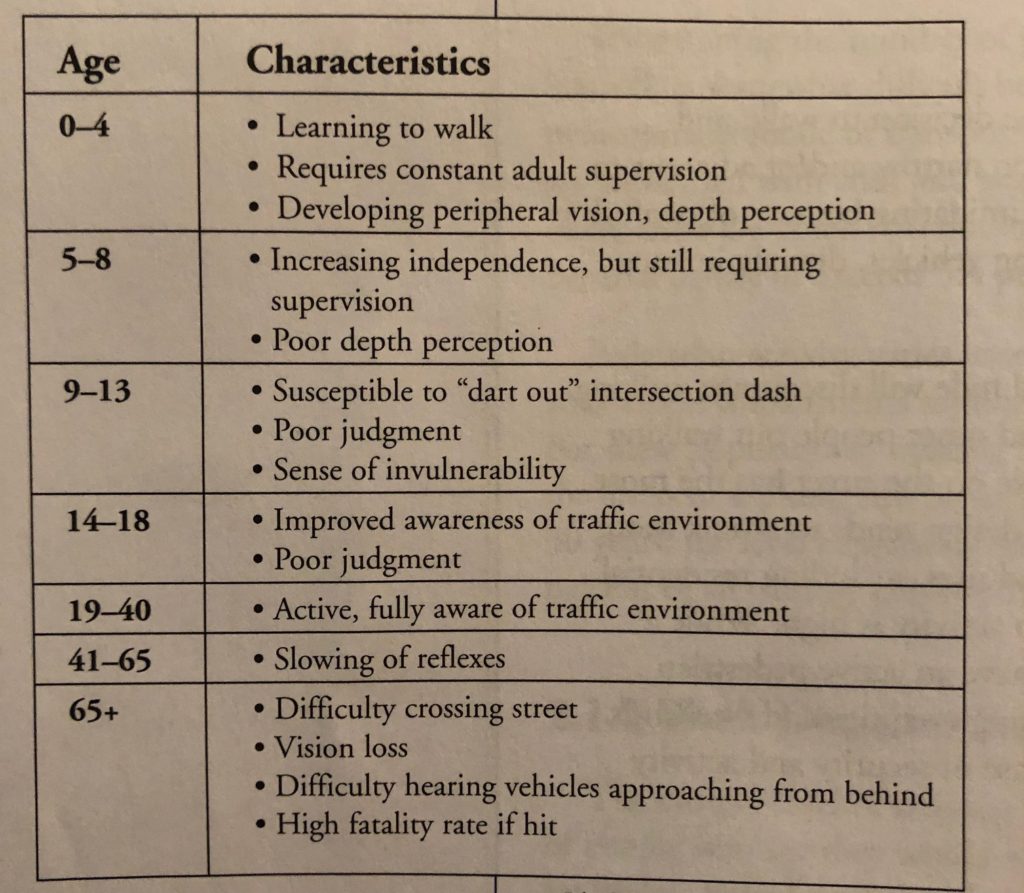
AASHTO Pedestrian Guide, Section 2.2 Characteristics of Pedestrians (page 10)
Experts Should Know Better. They Don’t.
One of my favorite twitter spats of 2018 was between Angie Schmitt of Streetsblog USA and Jonathan Adkins, executive director of the Governors Highway Safety Association.
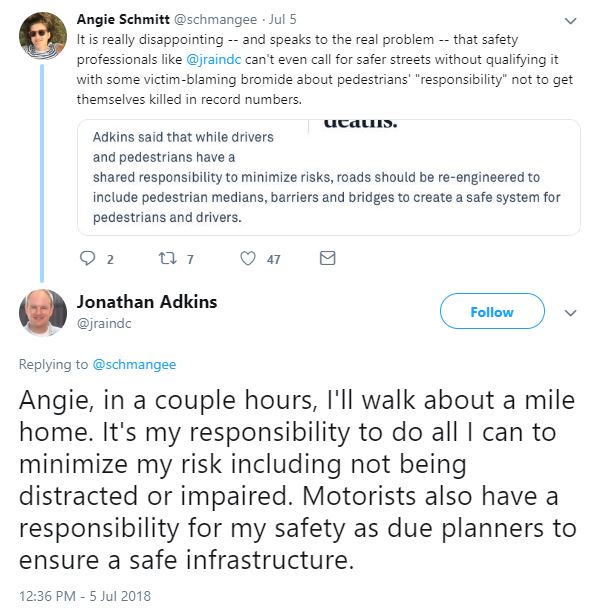
Adkins is clearly sipping heavily from motordom’s shared responsibility keg. Or is he just reflecting the lobbying influence on this organization?
I’ve long suspected GHSA is heavily influenced by the auto insurance industry and the state DOTs it lists as members (corporate sponsors shown in the image below). Read through those two links to see the organizations that GHSA lists as its member. Adkins own bio admits as much, “Adkins has built partnerships with a variety of leading organizations in the automotive, insurance and consumer products industries.” It doesn’t mention him building partnerships with AmericaWalks or the League of American Bicyclists. It’s all about the motordom industry.
We know state DOTs are not inclined to put responsibility on the motorists that they spend billions to subsidize and promote. We seem to have a connection between the insurance industry and their desires to limit responsibility for motordom’s deadly tendencies.
If you read the rest of the exchange between Schmitt and Adkins you’ll see he does make some points about road engineering. That’s a good thing and I have seen GHSA’s messaging shift the last couple years to acknowledge the issues associated with road design and small hints that they understand their long-standing quest to perfect human behavior is horribly misguided. Watch closely and keep the pressure on GHSA and their state member DOTs.
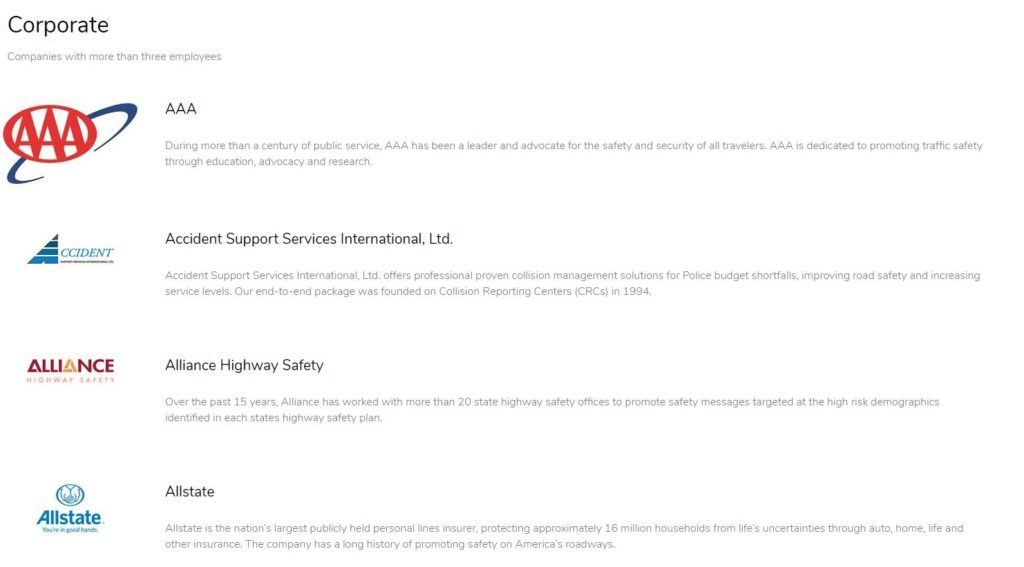
GHSA’s Corporate Sponsors
Previous Posts in the 12 Days of Safety Myths Series:
On the 3rd day of Safety Myths, my DOT gave to me…Lifesaving tchotchkes!
On the 2nd Day of Safety Myths, my DOT gave to me…Magical force field paint!
On the 1st day of Safety Myths, my DOT gave to me….bright, reflective vests!

